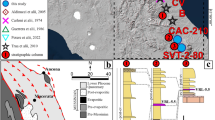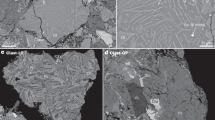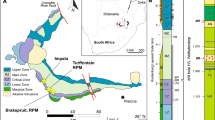Summary
Thirty five microbreccia fragments from Mare Fecunditatis recovered by the Luna 16 unmanned mission were studied inPTS by optical microscopy. Bulk compositions were determined by scanning electron beam analysis, and microbreccia constituents (pyroxene, olivine, plagioclase, spinel-group minerals, glasses) were analyzed with the electron microprobe. Results: Microbreccia fragments have bulk and mineral compositions distinctly different from those of aluminous basalt fragments from the same site: FeO, alkalis and FeO/MgO are lower and Cr2O3 is higher in the microbreccia fragments. Furthermore, microbreccia fragments are predominantly olivine-normative, whereas the basalt fragments are predominantly quartz-normative. In addition, in the microbreccia fragments, pyroxene compositions cover the range typical of pyroxenes from Luna 16 basalts but extend to more Mg-rich and Ca-poor compositions. Pyroxferroites found in aluminous basalt fragments were not observed in the microbreccia fragments. Plagioclase populations cluster at ⊂) An95 in the microbreccia fragments as compared to ⊂) An90 in the basalt fragments. Compositions of basaltic glasses from within the microbreccia fragments are similar to those from the soil. Conclusions: We found evidence that at the Luna 16 site, two major basalt types are present. One is represented by the 3.42 b.y. old aluminous basalt fragments, the other by the dominant component in the microbreccia fragments and basaltic glasses. The microbreccia fragments and basaltic glasses represent a here tofore unknown lunar basalt type for which we calculate a flatREE pattern with abundances approximately 10× chondritic, thus making it one of the most primitive basalt types known from the Moon. We suggest that this basalt type formed by a relatively high degree of partial melting of a plagioclase bearing source rock at about 60–100 km depth. We further suggest that this basalt type represents older mare fillings now largely covered by younger flows. These younger flows are represented by the aluminous basalt fragments, a rock type that may have formed from a similar source rock by a relatively low degree of partial melting.
Zusammenfassung
35 Mikrobrekzien-Fragmente aus der Bodenprobe von Mar Foecunditatis, die von der unbemannten Sonde Luna 16 aufgesammelt wurde, sind in polierten Dünnschliffen mikroskopisch und mittels Elektronenstrahl-Mikrosonde untersucht worden. Pauschalzusammensetzungen der Mikrobrekzien-Fragmente wurden mittels integrierender Elektronen-Raster-Technik und die zusammensetzungen der Komponenten (Pyroxen, Olivin, Plagioklas, Minerale der Spinell-Gruppe und Gläser) mittels konventioneller Elektronenstrahl-Mikroanalyse bestimmt. Resultate: Die Mikrobrekzien-Fragmente unterscheiden sich in ihrer Pauschalzusammensetzung deutlich von den Aluminiumreichen Basaltfragmenten derselben Bodenprobe: FeO- und Alkaligehalte und das FeO/ MgO-Verhältnis sind niedriger und der Cr2O3-Gehalt ist höher in den Mikrobrekzien-Fragmenten. Weiters sind die Mikrobrekzien-Fragmente meist Olivin-normativ, während die Basaltfragmente meist Quarz-normativ sind. Auch die Pyroxenzusammensetzungen in den Mikrobrekzien-Fragmenten unterscheiden sich deutlich von jenen der Basaltfragmente durch einen hohen Anteil an Mg-reichen und Ca-armen Pyroxenen, die in den Basaltfragmenten nicht vorkommen. Weiters konnten Pyroxferroite, die typisch für die Luna 16 Basaltfragmente sind, in den Mikrobrekzien-Fragmenten nicht gefunden werden. Die Plagioklas-Zusammensetzungen in den Mikrobrekzien-Fragmenten zeigen ein ausgeprägtes Häufigkeitsmaximum bei ⊂) An95, wogegen das Maximum der Plagioklase in den Basaltfragmenten bei ⊂) An90 liegt. Die Zusammensetzung der Gläser in den Mikrobrekzien-Fragmenten und in den Bodenproben außerhalb der Fragmente ist identisch. Schlußfolgerungen: Die analytischen Daten zeigen, daß an der Luna 16 Landestelle zwei Basalttypen weit verbreitet sind. Der eine Typ ist durch die 3.42×109 Jahre alten Aluminium-reichen Basaltfragmente vertreten, der andere durch die Hauptkomponente der Mikrobrekzienfragmente und basaltischen Gläser. Letzterer repräsentiert einen bisher nicht bekannten Basalttyp vom Mond, der Olivin- und Plagioklas-reich ist und einen niedrigen Spurenelementgehalt hat. Die errechnete Häufigkeit der Seltenen Erden ist etwa 10× chondritische Häufigkeit und weitesgehend unfraktioniert. Dieser neue Basalttyp scheint somit einer der primitivsten zu sein, den wir bisher vom Monde kennen. Er repräsentiert wahrscheinlich eine Schmelze, die durch einen hohen Grad von partieller Aufschmelzung eines plagioklasführenden Ausgangsgesteins in einer Tiefe von etwa 60–100 km entstand. Dieser Basalttyp stellt wahrscheinlich ältere Füllungen des Mare Foecunditatis dar, welche später durch jüngere Basaltergüsse größtenteils bedeckt wurden. Diese jüngeren Basalte sind durch die Basaltfragmente repräsentiert und sind durch hohe Spurenelementgehalte charakterisiert. Die Zusammensetzung der jüngeren Basalte kann durch eine relativ geringe und jene der älteren (Brekzien-) Basalte durch einen hohen Grad partieller Aufschmelzung eines ähnlichen Ausgangsgesteines erklärt werden.
Similar content being viewed by others
References
Albee, A. L., Chodos, A. A., Gancarz, A. J., Haines, E. L., Papanastatssiou, D. A., Ray, L., F. Tera, Wasserburg, G. J., Wen, T., 1972: Mineralogy, petrology, and chemistry of a Luna 16 basaltic fragment, sample B-1. Earth Planet. Sci. Lett.13, 353–367.
Anderson, A. T., jr.,Smith, J. V., 1971: Nature, occurrence, and exotic origin of “gray mottled” (Luny Rock) basalts in Apollo 12 Soild and breccias. Proc. Lunar Sci. Conf. 2nd, 431–438.
Andre, C. G., Wolfe, R. W., Adler, I., 1978: Evidence for a high-magnesium subsurface basalt in Mare Crisium from orbital X-ray fluorescence data. In: Mare Crisium: The View from Luna 24 (Merrill, R. B., Papike, J. J., eds.), pp. 1–12. New York: Pergamon Press.
Andre, C. G., Wolfe, R. W., Adler, I., 1979: Are early magnesium-rich basalts widespread on the Moon? Lunar Planetary Sci.10, 36–37. Lunar and Planet. Institute, Houston.
Bence, A. E., Holzwarth, W., Papike, J. J., 1972: Petrology of bassaltic and monomineralic soil fragments from the Sea of Fertility. Earth Planet. Sci. Lett.13, 299–311.
Boyce, J. M., 1976: Ages of flow units in the lunar nearside maria based on Lunar Orbiter IV photographs. Proc. Lunar Sci. Conf. 7th, 2717–2728.
Busche, F. D., Prinz, M., Keil, K., Bunch, T. E., 1972,: Spinels and the petrogenesis of some Apollo 12 igneous rocks. Amer. Min.57, 1729–1747.
Dowty, E., Keil, K., Prinz, M., 1974: Igenous rocks from Apollo 16 rake samples. Proc. Lunar Sci. Conf. 5th, 431–445.
Green, J. A., Kurat, G., Keil, K., Prinz, M., 1972: Electron microprobe analyes of lithic fragments, glasses, chondrules, and minerals from Luna 16 fines. UNM Inst. of Meteoritics. Spec. Publ. No. 5, 16 pp.
Haggerty, S. E., 1972: Luna 16: An opaque mineral study and a systematic examination of compositional variations of spinels from Mare Fecunditatis. Earth Planet. Sci. Lett.13, 328–352.
Hubbard, N. J., Nyquist, L. E., Rhodes, J. M., Bansal, B. M., Wiesmann, H., Church, S. E., 1972: Chemical features of the Lunar 16 regolith sample. Earth Planet. Sci. Lett.13, 423–428.
Jakeš, P., Warner, J., Ridley, W. I., Brett, A. M., 1972: Petrology of a portion of the Mare Fecunditatis regolith. Earth Planet. Sci. Lett.13, 257–271.
Jerome, D. Y., Philippot, J. C., Brichet, E., 1972: Determination of 29 elements in Luna 16 soil by non-destructive activation analysis. Earth Planet. Sci. Lett.13, 436–440.
Keil, K., Kurat, G., Prinz, M., Green, J. A., 1972: Lithic fragments, glasses and chondrules from Luna 16 fines. Earth Planet. Sci. Lett.13, 243–256.
Kurat, G., Keil, K., Prinz, M., 1974: Petrology of some lithic fragments of alkalic highalumina basalt composition from Apollo 12 coarse fines. Tschermaks Min. Petr. Mitt.21, 179–195.
Kurat, G., Keil, K., Prinz, M., Nehru, C. E., 1972: Chondrules of lunar origin. Proc. Lunar Sci. Conf. 34d, 707–721.
Kurat, G., Kracher, A., Keil, K., Warner, R., Prinz., M., 1976: Composition and origin of Luna 16 aluminous mare basalts. Proc. Lunar Sci. Conf. 7th, 1301–1321.
Ma, M.-S., Schmitt, R. A., Nielsen, R. L., Warner, R. D., Taylor, G. J., Keil, K., 1979: Luna 16 basalts and breccias: New chemical and petrologic data. Lunar Planet. Sci.10, 762–764.
Nehru, C. E., Prinz, M., Dowty, E., Keil, K., 1974: Spinel-group minerals and ilmenite in Apollo 15 rake samples. Amer. Min.59, 1220–1235.
Papanastassiou, D. A., Wasserburg, G. J., 1972: Rb-Sr age of a Luna 16 basalt and the model age of lunar soils. Earth Planet. Sci. Lett.13, 368–374.
Philpotts, J. A., Schnetzler, C. C., Bottino, M. C., Schuhmann, S., Thomas, H. H., 1972: Luna 16: Some Li, K, Rb, Sr, Ba, rare earth, Zr, and Hf concentrations. Earth Planet. Sci. Lett.13, 429–435.
Reid, A. M., Jakeš, P., 1974: Luna 16 revisited: The case for aluminous mare basalts. Lunar Science5, 627–629. The Lunar Science Institute, Houston.
Reid, J. B., Taylor, G. J., Marvin, U. B., Wood, J. A., 1972: Luna 16: Relative proportions and petrologic significance of particles in the soil from Mare Fecunditatis. Earth Planet. Sci. Lett.13, 286–298.
Ridley, W. J., 1975: On high-alumina mare basalts. Proc. Lunar Sci. Conf. 6th, 131–145.
Steele, I. M., Smith, J. V., 1972: Mineral and bulk compositions of three fragments from Luna 16. Earth Planet. Sci. Lett.13, 323–327.
Stöffler, D., Knöll, H.-D., 1977: Composition and origin of plagioclase, pyroxene, and olivine clasts of lunar brecias 14006, 14063, 14066, 14311, 14320 and 14321. Proc. Lunar Sci. Conf. 8th, 1849–1867.
Taylor, S. R., 1975: Lunar Science: A Post-Apollo View, 372 pp. New York: Pergamon.
Taylor, S. R., Jakeš, P., 1974: The geochemical evolution of the moon. Proc. Lunar Sci. Conf. 5th, 1287–1305.
Vinogradov, A. P., 1971: Preliminary data on lunar ground brought to Earth by automatic probe Luna 16. Proc. Lunar Sci. Conf. 2nd, 1–16.
Warner, J. L., 1972: Metamorphism of Apollo 14 breccias. Proc. Lunar Sci. Conf. 3rd, 623–643.
Wood, J. A., 1975: Glass compositions as a clue to unsampled mare basalt lithologies. Conf. on Origin of Mare Basalts and their Implications for Lunar Evolution. Lunar Science Institute, Houston, Texas, 194–198.
Author information
Authors and Affiliations
Additional information
With 9 Figures
Rights and permissions
About this article
Cite this article
Kurat, G., Kracher, A. & Keil, K. Luna 16 microbreccia lithic fragments: Samples of an early basalt filling of mare fecunditatis. TMPM Tschermaks Petr. Mitt. 27, 41–66 (1980). https://doi.org/10.1007/BF01081862
Received:
Accepted:
Issue Date:
DOI: https://doi.org/10.1007/BF01081862




